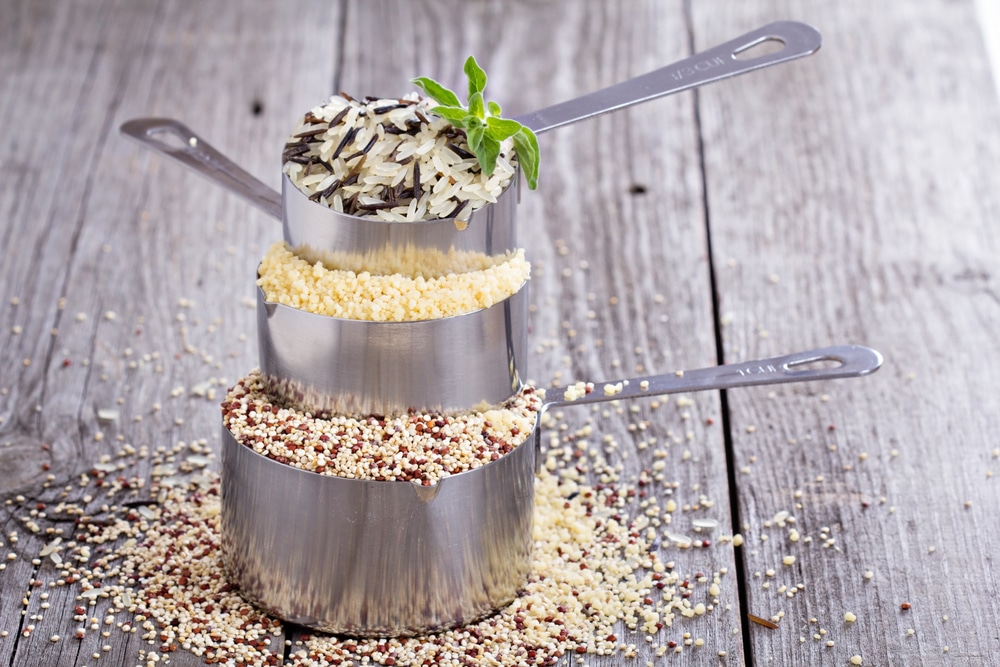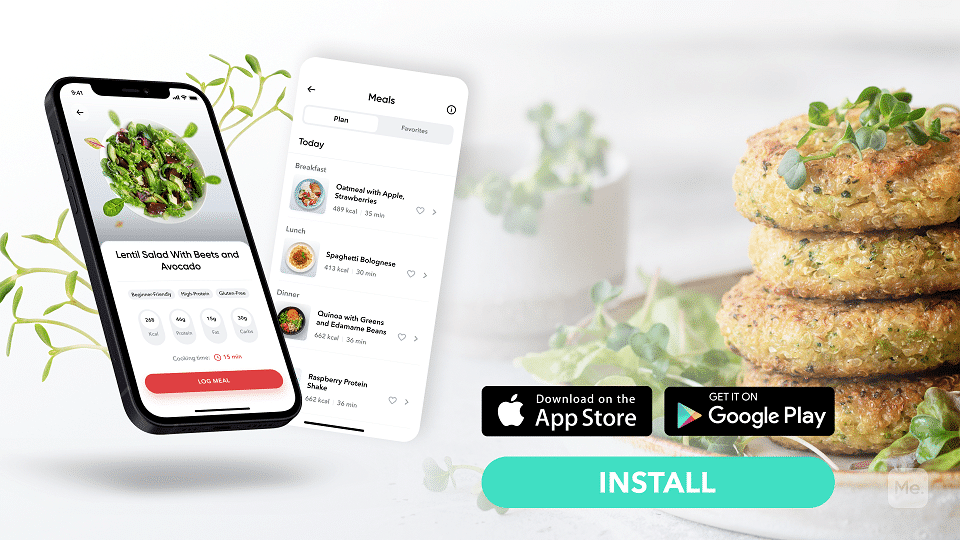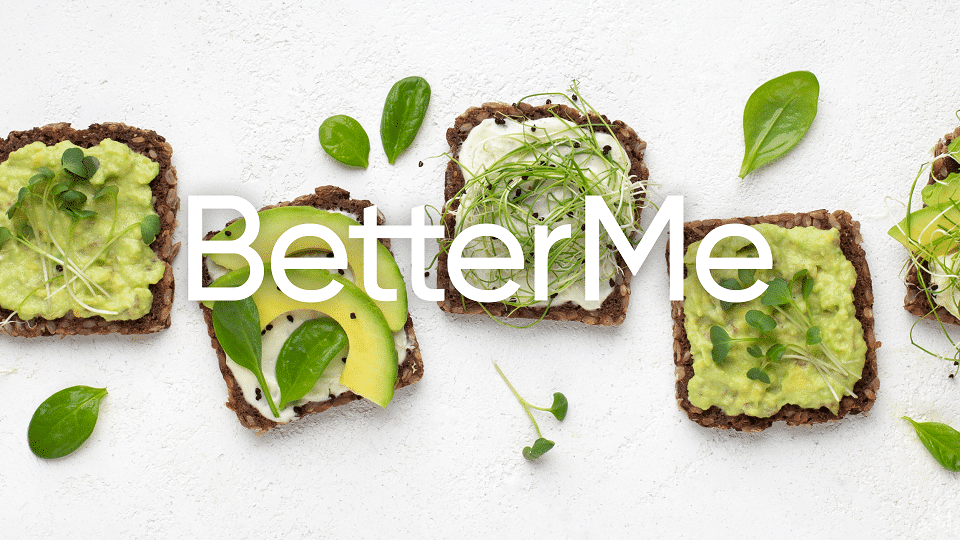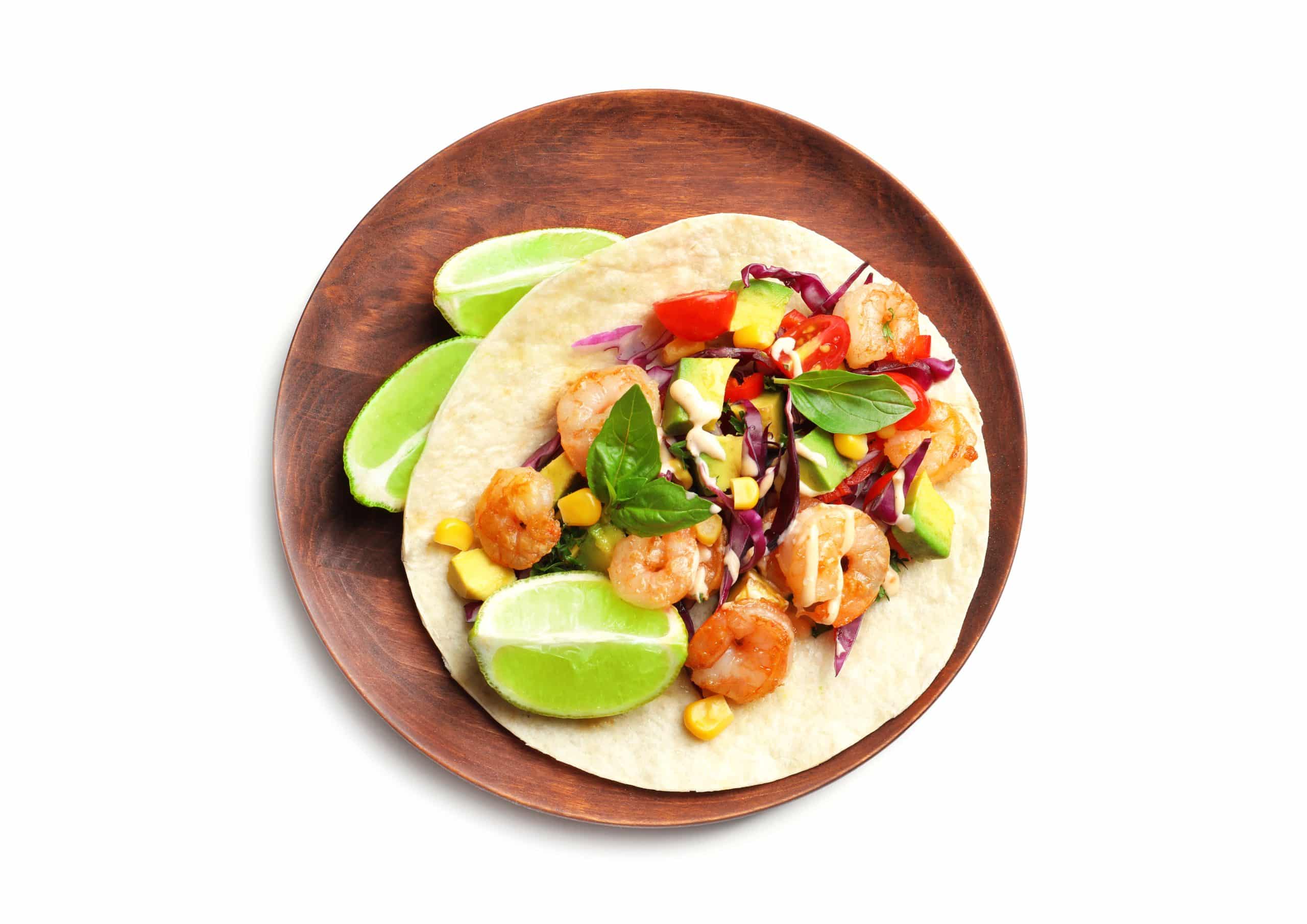First, it was gluten, then it was dairy, and now it’s grains. It seems like every few years there’s a new food group that’s being demonized by the dieting community. The grain-free diet is the latest fad, but is it actually healthy? We have asked the experts to weigh in. The grain-free diet is based on the premise that grains are inflammatory and therefore, eliminating them from your diet will lead to better health. There is a small amount of evidence to support this claim. But like with most diet decisions, there’s also evidence to the contrary. It really comes down to what works best for you and your body. Read on to know exactly what a grain-free diet is, who it may work for, and who shouldn’t try it.
What Is A Grain-Free Diet?
Botanically speaking, grains are seeds, but the word “grain” is often used to describe the edible seeds of certain grasses. These grasses include wheat, rye, oats, barley, sorghum, and rice.
Other grains include corn, millet, teff, amaranth, buckwheat, and quinoa.
For the most part, grains are composed of three parts: the bran, the germ, and the endosperm.
The bran is the outer layer of the grain and is rich in fiber, vitamins, and minerals. The germ is the innermost layer of the grain and contains essential fatty acids, protein, and some B vitamins.
The endosperm is the starchy middle layer of the grain and is primarily composed of carbohydrates.
The troublesome component in some grains is gluten, a protein found in wheat, barley, and rye. Gluten has been shown to be inflammatory for some people (more on this later) (7).
A grain-free diet is one that eliminates all forms of grains. This includes any food made with wheat, rye, barley, oats, rice, corn, millet, teff, amaranth, buckwheat, or quinoa.
So, a grain-free diet would consist mostly of meats, vegetables, fruits, nuts, and seeds.
It’s more restrictive than the gluten-free diet, which allows for some types of grains (such as oats and rice).
Is It Healthy To Not Eat Grains?
There might be some benefits of a grain-free diet. They include:
May Help Treat Certain Health Conditions
There’s some evidence that suggests a grain-free diet may help treat certain health conditions, such as:
Celiac Disease
This is an autoimmune disorder that’s triggered by gluten. When people with celiac disease eat gluten, it damages the lining of their small intestine, which prevents them from absorbing nutrients (10).
A gluten-free diet is the only treatment for celiac disease (8).
Non-Celiac Gluten Sensitivity
This is a condition in which people experience symptoms after eating gluten, but they don’t have celiac disease.
There’s no scientific consensus on what causes non-celiac gluten sensitivity, but it’s believed to be an immune reaction to gluten.
Symptoms of non-celiac gluten sensitivity include bloating, abdominal pain, headaches, brain fog, and fatigue. Eliminating gluten from your diet is the only way to manage this condition (14).
Autoimmune Disorders
There’s some evidence to suggest that a grain-free diet may help treat other autoimmune disorders, such as lupus, rheumatoid arthritis, and multiple sclerosis (5).
It’s not fully understood why this may help some people with non-celiac autoimmune diseases, but we do know that autoimmune disorders can be related and people with one often have or later develop another.
Read More: Is Barley Gluten Free? The Scientific Truth Behind This Grain
May Aid Weight Loss
A grain-free diet may also aid weight loss. This is because eliminating grains from your diet often results in eating fewer calories (12).
Grains are also high on the glycemic index, which means they can cause spikes in blood sugar levels. This can lead to cravings and overeating (12).
So, if you’re trying to lose weight, eliminating grains may help you achieve your goal.
However, it’s important to note that any diet that results in eating fewer calories will likely cause weight loss. That said, it’s not likely that the weight loss associated with a grain-free diet is due to the elimination of grains. It is most probably due to the reduction in calories.
May Improve Digestion
A grain-free diet may also improve digestion for certain people. This is because some people might have trouble digesting gluten, the protein found in wheat, barley, and rye.
When gluten isn’t properly digested, it can irritate the lining of the small intestine and cause digestive issues, such as bloating, abdominal pain, and diarrhea. Eliminating gluten-containing grains from your diet can help improve digestion if you are one of those people (4).
May Reduce Inflammation
A grain-free diet may also help reduce inflammation. This is because grains can cause inflammation in some people.This is especially true for people with celiac disease or non-celiac gluten sensitivity.
Inflammation is a normal immune response that helps protect your body from infection and injury. However, chronic inflammation is associated with a variety of health problems, such as heart disease and arthritis (2).
If you’re struggling with chronic inflammation and grains happen to cause inflammation for you, eliminating grains from your diet may help.
May Help Alleviate Pain
Certain health conditions, such as fibromyalgia, are characterized by chronic pain, and patients sometimes also present with symptoms similar to those with gluten intolerance. A grain-free diet may help alleviate symptoms for some people with this condition. This is likely due to the fact that some people with fibromyalgia are thought to have an underlying gluten sensitivity (13).
However, more research is needed to confirm these effects.
Intense sweat sessions, working weight loss tips, lip-smacking recipes come in one package with the BetterMe app. And all of it is at your fingertips, start transforming your life now!
Possible Disadvantages Of A Grain-Free Diet
While a grain-free diet has many potential benefits, there are also some disadvantages to consider.
May Be Difficult To Follow
A grain-free diet can be difficult to follow. This is because grains are found in a wide variety of foods, including bread, pasta, cereal, and baked goods.
What’s more, many processed foods contain hidden sources of grains. For example, many soups and sauces contain wheat flour.
So, if you’re considering a grain-free diet, you’ll need to be diligent about reading labels and checking ingredients lists. You may also need to cook more meals at home, as it can be difficult to find grain-free options when eating out.
May Cause Nutritional Deficiencies
A grain-free diet may also cause nutritional deficiencies. This is because grains are a good source of fiber, vitamins, and minerals.
What’s more, many refined grains have been enriched with nutrients that are lost during the refining process.
So, if you eliminate grains from your diet, you’ll need to make sure you’re getting these nutrients from other sources. You may also need to take supplements to prevent deficiencies. It’s important to work closely with your doctor and registered dietitian on a diet like this to help you avoid nutrient deficiencies or malnutrition.
May Raise The Risk Of Certain Health Problems
While a grain-free diet has many potential health benefits, it may also raise the risk of certain health problems.
For example, a grain-free diet may increase the risk of constipation. This is because grains are a good source of fiber, which helps promote regular bowel movements (3).
What’s more, a grain-free diet may also raise the risk of heart disease. This is because whole grains contain nutrients that protect against heart disease, such as fiber, magnesium, and vitamin E (1).
So, if you’re considering a grain-free diet, be sure to talk to your doctor first. They can help you determine if this diet is right for you.
Read More: Why Is Gluten Bad For You? Analyzing The Harm Behind This Food
What Do You Eat On A Grain-Free Diet?
If you decide to try a grain-free diet, there are many delicious and nutritious foods you can eat.
- Vegetables: All vegetables are allowed on a grain-free diet. This includes leafy greens, cruciferous vegetables, root vegetables, and more.
- Fruits: All fruits are allowed on a grain-free diet. This includes fresh, frozen, or canned fruits.
- Meat: All types of meat are allowed on a grain-free diet. This includes beef, pork, chicken, turkey, lamb, and more.
- Fish: All types of fish are allowed on a grain-free diet. This includes fresh, frozen, or canned fish.
- Eggs: All types of eggs are allowed on a grain-free diet. This includes whole eggs, egg whites, and more.
- Nuts and seeds: All types of nuts and seeds are allowed on a grain-free diet. This includes almonds, walnuts, sunflower seeds, and more.
- Dairy: All types of dairy are allowed on a grain-free diet. This includes milk, cheese, yogurt, and more.
- Oils and fats: All types of oils and fats are allowed on a grain-free diet. This includes olive oil, coconut oil, avocado oil, and more.
While there are many healthy foods you can eat on a grain-free diet, there are also some unhealthy options to avoid or limit.
- Processed meats: Processed meats, such as bacon and sausage, are high in saturated fat and sodium. They should be avoided on a grain-free diet.
- Junk food: Junk food, such as chips and candy, is high in calories and low in nutrients. It should be avoided on a grain-free diet.
- Alcohol: Alcohol is high in calories and can contribute to weight gain. It should be limited on a grain-free diet. Furthermore, most alcohols are derived from grains and are not allowed on a grain-free diet.
- Sugary drinks: Sugary drinks, such as soda and juice, are high in calories and can contribute to weight gain. They should be limited when on a grain-free diet.
What Can’t You Eat On A Grain Free Diet
According to the Grains & Legumes Nutrition Council, there are three types of grains (15):
- Grains containing gluten: wheat, rye, barley, bulgar, oats, and triticale.
- Grains without gluten: corn, brown rice, quinoa, sorghum, teff, and millet
- Gluten-free pseudo-cereals: buckwheat, quinoa, amaranth, and teff.
If you’re following a grain-free diet, you need to avoid all grains, including those that are gluten-free. If you are following a gluten-free diet, you just need to avoid the gluten-containing ones.
In addition to grains, you must avoid any food containing flour or the grains listed above. This includes bread, pasta, cereal, crackers, and more.
You should also avoid processed foods that contain grains or flour. This includes many snacks, desserts, and packaged foods. You’ll need to get good at reading labels carefully.
Whether you’re looking to simply pep up your fitness routine, jazz up your diet with mouth-watering low-calorie recipes or want to get your act together and significantly drop that number on your scale – BetterMe app has got you covered! Improve your body and revamp your life with us!
How To Start A Grain-Free Diet
If you’re interested in trying a grain-free diet, there are a few things you need to do to get started.
Shop The Perimeter
When you’re at the grocery store, stick to the perimeter. This is where you’ll find most of the fresh, whole foods that are allowed on a grain-free diet.
The center aisles of the grocery store are typically filled with processed foods that contain grains. So, it’s best to avoid these aisles when you’re shopping for grain-free foods.
Read Labels
It’s important to read food labels when you’re following a grain-free diet. This is because many packaged foods contain hidden sources of grains.
For example, a food label might list “wheat flour” as an ingredient. However, wheat flour can also be listed as “enriched flour,” “bleached flour,” or “self-rising flour.”
That said, it’s important to read food labels carefully to make sure a food is truly grain-free.
Prepare Your Own Meals
One of the best ways to stick to a grain-free diet is to prepare your own meals. This way, you’ll know exactly what ingredients are in your food.
It’s also a good idea to cook in bulk and freeze extra servings for future meals. This will help you save time and money in the long run.
Use Vegetable Substitutes
In the absence of grains, you can use starchy vegetables as substitutes. For example, you can use cauliflower rice in place of regular rice.
You can also use spaghetti squash in place of pasta. And, you can use a slice of avocado instead of bread for a sandwich.
There are many other vegetable substitutes that you can use to make your favorite grain-based foods.
The Bottom Line
A grain-free diet has many potential benefits, including weight loss, symptom relief, and reduced inflammation. However, there are also some potential disadvantages to consider, such as nutritional deficiencies and difficulty following the diet. Talk to your doctor before starting a grain-free diet to make sure it’s right for you.
Get your personalized
meal plan!
DISCLAIMER:
This article is intended for general informational purposes only and does not serve to address individual circumstances. It is not a substitute for professional advice or help and should not be relied on for making any kind of decision-making. Any action taken as a direct or indirect result of the information in this article is entirely at your own risk and is your sole responsibility.
BetterMe, its content staff, and its medical advisors accept no responsibility for inaccuracies, errors, misstatements, inconsistencies, or omissions and specifically disclaim any liability, loss or risk, personal, professional or otherwise, which may be incurred as a consequence, directly or indirectly, of the use and/or application of any content.
You should always seek the advice of your physician or other qualified health provider with any questions you may have regarding a medical condition or your specific situation. Never disregard professional medical advice or delay seeking it because of BetterMe content. If you suspect or think you may have a medical emergency, call your doctor.
SOURCES:
- A Clinician’s Guide to Healthy Eating for Cardiovascular Disease Prevention (2019, pubmed.gov)
- Chronic Inflammation (2021, nih.gov)
- Effect of dietary fiber on constipation: a meta analysis (2012, pubmed.gov)
- Efficacy of the Autoimmune Protocol Diet for Inflammatory Bowel Disease (2017, nih.gov)
- Gluten-free diet can ameliorate the symptoms of non-celiac autoimmune diseases (2022, pubmed.gov)
- Impact of Dietary Fiber Consumption on Insulin Resistance and the Prevention of Type 2 Diabetes (2018, pubmed.gov)
- Long term gluten consumption in adults without celiac disease and risk of coronary heart disease: prospective cohort study (2017, nih.gov)
- Micronutrient Deficiency in Inflammatory Bowel Diseases: Cause or Effect? (2020, nih.gov)
- Neuropsychiatric manifestations in celiac disease (2019, pubmed.gov)
- Screening for celiac disease in the general population and in high-risk groups (2015, nih.gov)
- The Canadian Trial of Carbohydrates in Diabetes (CCD), a 1-y controlled trial of low-glycemic-index dietary carbohydrate in type 2 diabetes: no effect on glycated hemoglobin but reduction in C-reactive protein (2008, pubmed.gov)
- The Effect of Low-Fat and Low-Carbohydrate Diets on Weight Loss and Lipid Levels: A Systematic Review and Meta-Analysis (2020, pubmed.gov)
- The Effects of a Gluten-free Diet Versus a Hypocaloric Diet Among Patients With Fibromyalgia Experiencing Gluten Sensitivity-like Symptoms: A Pilot, Open-Label Randomized Clinical Trial (2017, pubmed.gov)
- The prevalence of plant food allergies: a systematic review (2008, nih.gov)
- Types of Grains (n.d., glnc.org.au)














